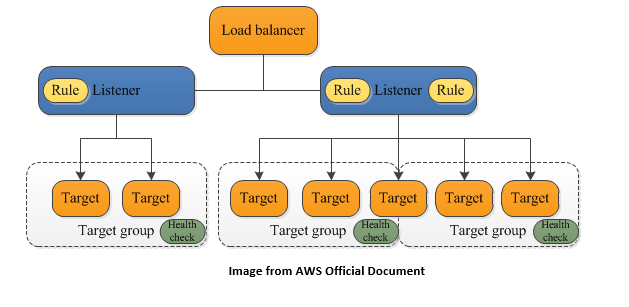Elastic Load Balancer - Part2
 Utkarsh Rastogi
Utkarsh Rastogi
Amazon Cloud Concepts Learning --> Day11
Application Load Balancer (ALB)
Functions at 7th Layer of OSI Model.
Works based on listener rule priority from lowest to highest.
Supports Path and Host based routing.
Support for redirecting requests from one URL to another.
Support for registering targets by IP address, including targets outside the VPC for the load balancer.
Support for registering Lambda functions as targets.
Support for returning a custom HTTP response. Cross-zone load balancing is always enabled.
Support HTTP and HTTPS At least two Availability Zone subnets (Each subnet must be from a different Availability Zone) --> while creation of ALB.
You are charged for each hour or partial hour that an ALB is running, and the number of Load Balancer Capacity Units (LCU) used per hour
ALB Components

For clients, a load balancer acts as a single point of contact. The load balancer divides up incoming application traffic among several targets in different Availability Zones, such EC2 instances.
A listener uses the protocol and port that you set to listen for connection requests from clients. We need to define a rule for each listener that includes target group, condition, and priority.

- Using the protocol and port number you provide, each target group forwards requests to one or more registered targets, such as EC2 instances. A target may be registered with more than one target group. Health checks may be set up for each target group separately.
Application Load Balancer Limits
Below mentioned tables includes some basic limitations for ALB.

Network Load Balancer (NLB)
Functions at 4th Layer of OSI Model.
Support TCP, UDP, TCP_UDP, and TLS protocols.
Support for static IP addresses for the load balancer.
At least one subnet is required.
Cross-zone load balancing is disabled by default.
After a Network Load Balancer is created, it cannot have its Availability Zones disabled, but more Availability Zones can be enabled.
You are charged for each hour or partial hour that a NLB is running, and the number of Network Load Balancer Capacity Units (NLCU) used by Network Load Balancer per hour.
Network Load Balancer Limits
Below mentioned tables includes some basic limitations for NLB.

Gateway Load Balancer (GLB)
Functions at 3rd and 4th Layer of OSI Model.
With the help of gateway load balancers, you can scale, install, and maintain virtual appliances including intrusion detection and prevention systems, firewalls, and deep packet inspection systems.
Runs within one Availability Zone (AZ).
It improves availability and removes potential points of failure from your network.
You are charged for each hour or partial hour that a GLB is running, and the number of Gateway Load Balancer Capacity Units (GLCU) used by Gateway Load Balancer per hour.
Gateway Load Balancer Limits
Below mentioned tables includes some basic limitations for GLB.

Classic Load Balancer (CLB)
Support for TCP and SSL listeners.
Functions at 4/7 Layer of OSI Model.
Legacy load balancer that is no longer recommended for new applications.
Support for sticky sessions using application-generated cookies.
You are charged for each hour or partial hour that a Classic Load Balancer is running and for each GB of data transferred through your load balancer.
Classic Load Balancer Limits
Below mentioned tables includes some basic limitations for CLB.

Conclusion
Application Load Balancer (ALB)
Default Idle Timeout --> 60 seconds
Load Balancer Type --> Layer 7
Target Type --> IP, Instance, Lambda
Protocol Listeners --> HTTP, HTTPS, gRPC
Load Balancer Detection Protection --> Yes
Network Load Balancer (NLB)
Default Idle Timeout --> 350 seconds
Load Balancer Type --> Layer 4
Target Type --> IP, Instance, Application Load Balancer
Protocol Listeners --> TCP, UDP, TLS
Load Balancer Detection Protection --> Yes
Gateway Load Balancer (GLB)
Default Idle Timeout --> TCP flow – 350 seconds and non-TCP flow 120 seconds
Load Balancer Type --> layer 3 gateway + Layer 4 Load balancing
Target Type --> IP, Instance, Lambda
Protocol Listeners --> IP
Load Balancer Detection Protection --> Yes
Classic Load Balancer (CLB)
Default Idle Timeout --> 60 seconds
Load Balancer Type --> Layer 4/7
Protocol Listeners --> TCP, SSL/TLS, HTTP, HTTPS
Load Balancer Detection Protection --> No
"Thank you for reading! If you found this blog helpful, don't forget to subscribe for more insightful content. Your support keeps me motivated to bring you valuable insights. Stay updated and never miss out on our latest posts. Feel free to leave comments or suggestions for future topics. Happy learning!"
https://awslearner.hashnode.dev/amazon-web-services-via-category
Subscribe to my newsletter
Read articles from Utkarsh Rastogi directly inside your inbox. Subscribe to the newsletter, and don't miss out.
Written by

Utkarsh Rastogi
Utkarsh Rastogi
👨💻 AWS Cloud Engineer | Around 6 years of Corporate Experience | Driving Innovation in Cloud Solutions 🔧 Day-to-Day Tasks: Specialize in creating AWS infrastructure for Migration Projects. Leveraging services such as S3, SNS, SQS, IAM, Lambda, System Manager, Kinesis, OpenSearch, Cognito, Storage Gateway, Cloud Watch, API Gateway, AWS Event Scheduler, Secret Manager, ECS, Application Load Balancer, VPC among others. Additionally, I excel in crafting Splunk Dashboards and implementing alerting mechanisms for Cloud Watch logs to monitor failures. My approach involves constructing AWS infrastructure using the Serverless framework and Cloud Formation templates, while automating tasks through Boto3 (Python Scripting) Lambdas. 🎯 Passion: I am deeply passionate about continuously learning new technologies and eagerly anticipate the transformative impact of cloud computing on the tech landscape. 📧 Connect: Feel free to reach out to me at awslearningoals@gmail.com. Let's connect and explore potential collaborations! https://www.linkedin.com/in/rastogiutkarsh/